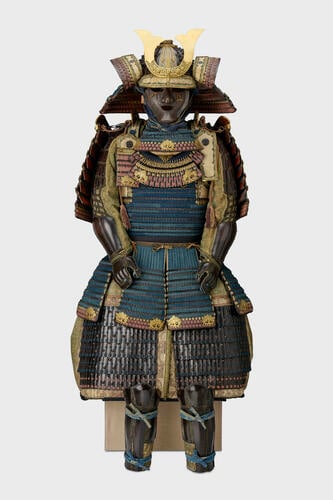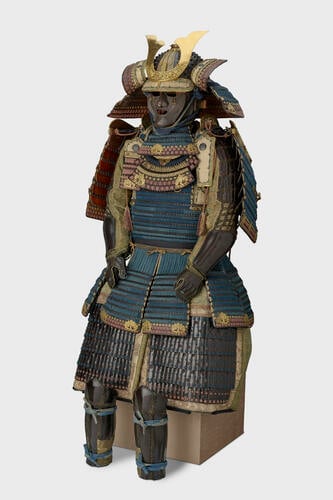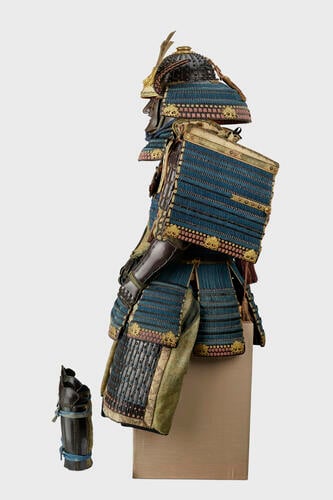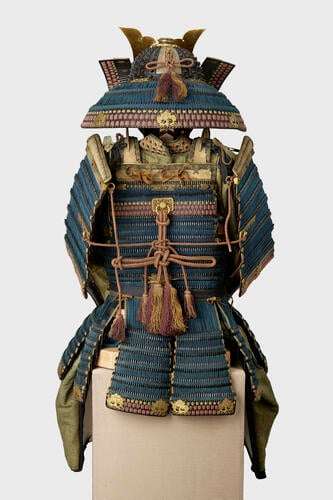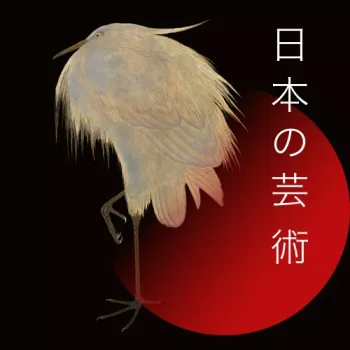Armour (dōmaru) 1750 - 1850
Steel, lacquer, gold, shakudō, iron, gilt bronze, gilt and silvered copper, cotton, silk brocade, stencilled doe-skin, gilt-leather linings, horn toggles | 151.0 × 71.0 × 70.0 cm (overall, approx., when mounted) (whole object) | RCIN 64125
-
This armour is of the ‘body-wrapped’ (dōmaru) form prized by higher-ranking samurai for its lightness and flexibility. One major difference from earlier, heavier armours was the removal of the doe-skin covering (tsurubashiri) on the cuirass (dō). Another change was the replacement of the two protective fittings for the cuirass toggles known as sendan-no-ita and kyūbi-no ita
gyōyō.
Curiously, this armour has the earlier fittings rather than the gyōyō. This perhaps reflects the revival around 1800 of a nationalistic spirit in Japan that harked back to the ‘Golden Age’ of the samurai in the Kamakura (1185–1333) and Nambokuchō (1333–92) periods. In the early nineteenth century, swords and armour were produced which reflected the styles and tastes of those periods, but parade armours used in sankin kōtai at this time also incorporated defensive features that would not have been found on early armours. These additional defences were ornamental rather than functional, and historical accuracy was not of prime importance: the antiquarian style of the armour was enough to invoke the samurai’s glorious military heritage.The heavy helmet with visible rivets and wide neck protector (shikoro) is in the Kamakura-period style called ‘star’ helmet (hoshi kabuto). It carries a three-bar family crest, possibly of the Sakuma clan, and this device is also found on the cuirass toggle protectors. Both the helmet (kabuto) and shoulder-guards (sode) are lined with gilded leather. The dō is constructed mainly of black lacquered individual iron lamellae (kozane) laced together in a flexible manner: this is known as hon-kozane (‘real’ kozane) and is an indicator of a high-quality armour. The other parts of the armour are of lacquered leather formed in one piece to give the appearance of individual lamellae.
The decorative metalwork is of fine quality and includes fittings of intricately carved and gilt-copper alloy and shakudō. Of particular note is the superb metalwork detail on the shikoro, the throat protectors (yodare-kake and nodowa), toggle protectors (sendan-no-ita and kyūbi-no ita) and tassets (kusazuri), which are of gilt-copper alloy and take the form of cherry trees with visible roots. While the armour may never have actually been worn, it would certainly have been displayed in the tokonoma, the alcove in the traditional Japanese house where seasonal objects are displayed, to be admired by honoured guests.
At the 1965 ‘Exhibition of Japanese Armour’ at the Tower of London, this armour was described as having been given to Prince George of Wales by the Emperor Meiji during his visit to Japan in 1881. Although a gift of armour is not mentioned in the official accounts of the tour, there is no strong reason to doubt this provenance: the Emperor Meiji had given the prince’s uncle, Prince Alfred, Duke of Edinburgh, an armour during his visit in 1869 and such objects were a traditional and impressive diplomatic gift. It is even possible that RCIN 64124 was given to the prince’s brother, Prince Albert Victor, on the same occasion.
Text adapted from: Japan: Courts and Culture (2020)Provenance
Possibly presented to King George V when Prince George of Wales by the Emperor Meiji, 1881
Sent on long-term loan to Maidstone Museum with RCIN 64124 on 23 February 1929 (RA/MRH/GV/GEN/340/1-8); returned 7 April 1998. -
Creator(s)
(nationality) -
Medium and techniques
Steel, lacquer, gold, shakudō, iron, gilt bronze, gilt and silvered copper, cotton, silk brocade, stencilled doe-skin, gilt-leather linings, horn toggles
Measurements
151.0 × 71.0 × 70.0 cm (overall, approx., when mounted) (whole object)
Category
Object type(s)
Place of Production
Japan




